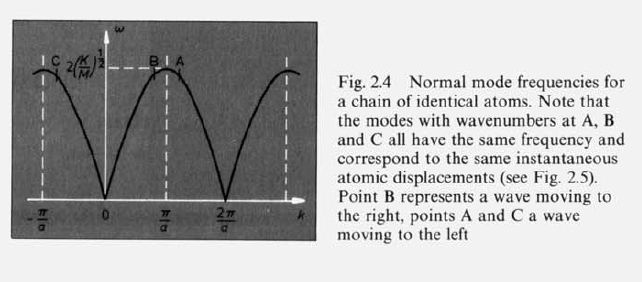Solution to Set 5: Difference between revisions
| Line 13: | Line 13: | ||
'''Derive the dispersion relation <math>\omega^{\alpha} (k)\;</math> for this chain''' | '''Derive the dispersion relation <math>\omega^{\alpha} (k)\;</math> for this chain''' | ||
* Index <math>\alpha = 1\;</math> for acoustic branch | |||
* '''Index <math>\alpha = 1\;</math> for acoustic branch''' | |||
Potential Energy <math>U = 1, 2, 3, ... n \;</math> | Potential Energy <math>U = 1, 2, 3, ... n \;</math> | ||
| Line 20: | Line 20: | ||
<math>U \cong \frac{1}{2} k \sum_{n} (U_n - U_{n-1}) \;</math> | <math>U \cong \frac{1}{2} k \sum_{n} (U_n - U_{n-1}) \;</math> | ||
<math>\Rightarrow m \ddot{U}_n = - k [2U_n - U_{n-1} - U_{n+1}] \;</math> | <math>\Rightarrow m \ddot{U}_n = - k [2U_n - U_{n-1} - U_{n+1}] = -m \omega U(t) \;</math> | ||
Eigenvectors of Modes A and B (defined arbitrarily) | |||
<math>u_m(t)=e^{i\omega t} u_m \;</math> | <math>u_m(t)=e^{i\omega t} u_m \;</math> | ||
< | <math>\Rightarrow -m \omega ^2 \ddot{\vec{u}}_n = - k \mathbf{M} \vec{u} \;</math> | ||
Band Matrix | |||
<math> | <math> | ||
\mathbf{M} = \begin{vmatrix} | \mathbf{M} = \begin{vmatrix} | ||
| Line 40: | Line 39: | ||
</math> | </math> | ||
<math>u_m (t) = e^{ik(na)- \omega t} \;</math> where <math>u_m \rightarrow u_n e^{ik(na)} \;</math> | <math>u_m (t) = e^{ik(na)- \omega t} = e^{i k R_n} \;</math> | ||
where | |||
<math>u_m \rightarrow u_n e^{ik(na)} \;</math> | |||
<math>R_n \;</math> = distance on some coordinate system | |||
<math>\Rightarrow -m \omega ^2 \vec{u} = - k [2 - e^{ik \alpha} - e^{-ik \alpha}] \;</math> | <math>\Rightarrow -m \omega ^2 \vec{u} = - k [2 - e^{ik \alpha} - e^{-ik \alpha}] \;</math> | ||
| Line 47: | Line 52: | ||
<math>\Rightarrow \omega (k) = 2 \sqrt{ \frac{k}{m} } |sin(ka)|</math> | <math>\Rightarrow \omega (k) = 2 \sqrt{ \frac{k}{m} } |sin(ka)|</math> | ||
* '''Index<math>\alpha = 2\;</math> for optical branch''' | |||
<math>u(R_n) \equiv e^{i k R_n} = cos (k a) \;<> | |||
<math>u_m (t) = e^{ik(na)- \omega t} = e^{i k R_n} \;</math> | |||
<math>\Rightarrow - m \omega^2 e^{ikna} = -k [2e^{ik(na)} - e^{ik(n+1)a} - e^{ik(n-1)a}] \;</math> | |||
<math>\Rightarrow m \omega^2 = k [2 - (e^{ika} + e^{-ika}] \;</math> | |||
<math>\Rightarrow \omega^2 = \frac{2k}{m} [1 - cos(ka)] = \;</math> | |||
[[Image:Dispersionrelation.jpg]] | [[Image:Dispersionrelation.jpg]] | ||
Revision as of 05:43, 2 March 2009
I have no idea what I'm doing - KimberlyWynne 03:11, 2 March 2009 (EST)
Diatomic harmonic chain
Problem 1
Given:
- a chain of atoms
- with alternating masses and
- connected with elastic springs with constant
- moving only in the x-direction
Derive the dispersion relation for this chain
- Index for acoustic branch
Potential Energy
Eigenvectors of Modes A and B (defined arbitrarily)
Band Matrix
where
= distance on some coordinate system
Derive and get:
- Index for optical branch
Problem 2
Determine the speed of sound for this chain. What is the lowest frequency of long-wavelength sound corresponding to the optical branch?
From my lecture notes:
where = speed of sound
Problem 3
Sketch the motion of the atoms corresponding to the edge of the Brillouin zone, both for the optical and the acoustic branch.
Problem 4
Determine the Debye temperature for this system, and determine the form of the specific heat in the limits of high and low temperatures.
Problem 5
Consider low temperatures () and determine the wavelength of the most abundant phonons (Hint: note the analogy with Wien's Law!)








![{\displaystyle \Rightarrow m{\ddot {U}}_{n}=-k[2U_{n}-U_{n-1}-U_{n+1}]=-m\omega U(t)\;}](https://wikimedia.org/api/rest_v1/media/math/render/svg/461b812664679855fe2267f3b2cb29ec477ba6b6)






![{\displaystyle \Rightarrow -m\omega ^{2}{\vec {u}}=-k[2-e^{ik\alpha }-e^{-ik\alpha }]\;}](https://wikimedia.org/api/rest_v1/media/math/render/svg/4f6a218fe9a00344679e78f96eb71bc19aa04fd9)



![{\displaystyle \Rightarrow -m\omega ^{2}e^{ikna}=-k[2e^{ik(na)}-e^{ik(n+1)a}-e^{ik(n-1)a}]\;}](https://wikimedia.org/api/rest_v1/media/math/render/svg/bf21eaf0cd6fff39dbaadf7d6c171483dc3d65fb)
![{\displaystyle \Rightarrow m\omega ^{2}=k[2-(e^{ika}+e^{-ika}]\;}](https://wikimedia.org/api/rest_v1/media/math/render/svg/7905effd4796eebe7dc833b85e383beac1df38e6)
![{\displaystyle \Rightarrow \omega ^{2}={\frac {2k}{m}}[1-cos(ka)]=\;}](https://wikimedia.org/api/rest_v1/media/math/render/svg/e84efca082bb8cb33a9b1776fa448c1245b9e2e9)





